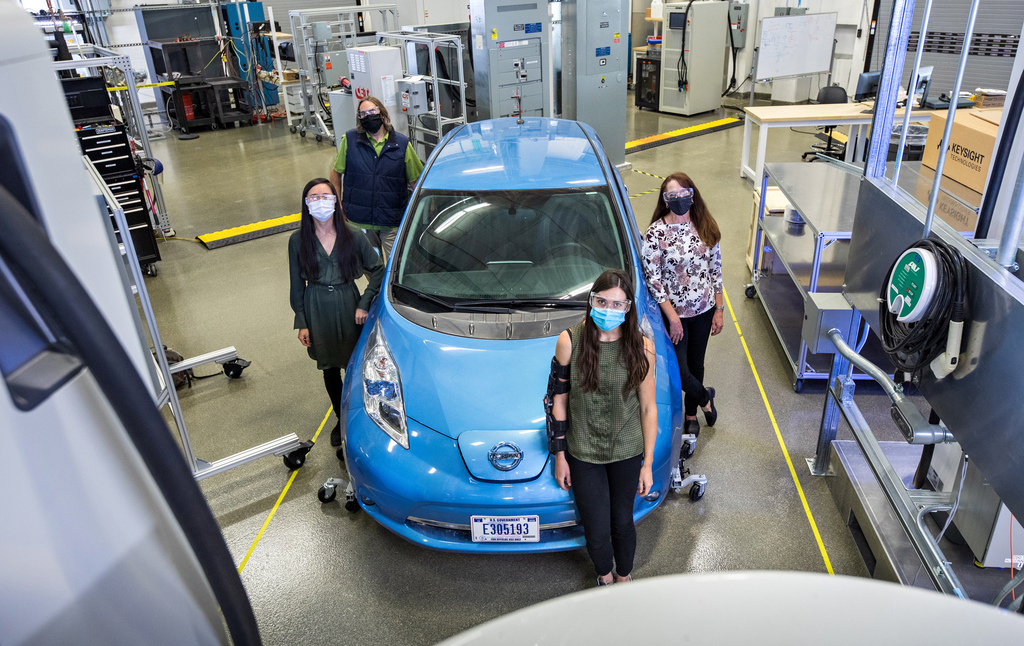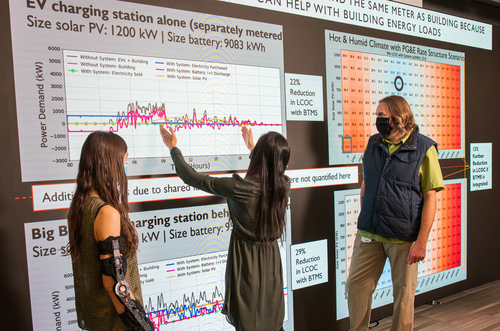Electric Vehicle Charging at Retail Locations Offers Convenience, Building Integration Opportunities

NREL researchers, clockwise from left, Darice Guittet, Eric Bonnema, Margaret Mann,
and Madeline Gilleran are part of a team identifying the optimal design for high-power
vehicle chargers, storage, and building load management based on climate, building
type, and utility rate structure. Photo by Werner Slocum, NREL
For many people, the next car you buy may be an electric vehicle (EV). New government mandates aim to scale back conventional engines and boost EV sales 50% by 2030.
In response, researchers are intensifying efforts to understand and mitigate the impacts of increased power demand from EVs on the electric grid. Recent analysis at the National Renewable Energy Laboratory (NREL) highlights the potential market for behind-the-meter storage (BTMS) systems and EV charging integration at big-box retail locations.
To achieve widespread electrification of personal vehicles, the transportation industry must adapt to the unique constraints of middle- and lower-income households. Currently, EV owners have limited public options, relying heavily on overnight charging at their private residences. With multi-family dwellings making up an increasing percentage of the U.S. population, many people lack access to convenient at-home charging. Big-box retailers may offer a solution, seamlessly integrating EV charging with the drivers’ weekly errands. This option is also appealing to retailers, as around 90% of EV drivers typically make a purchase while charging on location.
A new study from NREL researchers published in Advances in Applied Energy compares load profiles from potential EV charging stations against those of big-box retail grocery stores, such as Walmart, Target, or Costco, to assess how the electricity demands of specific sites may change by adding EV charging.
“Our research is the first of its kind to evaluate the possible impacts of EV charging on the monthly electricity use, peak power demand, and annual electricity bill for big-box retail grocery stores,” said Madeline Gilleran, NREL researcher and project lead. “Although there are several recent studies on the impacts of residential EV charging, we wanted to look into charging scenarios that accommodate a greater number of drivers and identify integration opportunities between buildings and EV charging stations.”
For this project, researchers developed a modeling method incorporating geographical and infrastructural inputs and simulated response models to combine building and EV station demand profiles. The team used real-world data from a big-box retail grocery store building in Centennial, Colorado, to model building demand profiles for different climate zones across the country. To determine EV station demand profiles, researchers turned to NREL’s Electric Vehicle Infrastructure – Energy Estimation and Site Optimization Tool (EVI-EnSite), exploring a variety of vehicle charging scenarios to account for the lack of existing data.
Findings indicate that EV charging would significantly impact the monthly peak power demand for a big-box retail grocery store, in some cases increasing demand at the site by over 250%. These increases are highest with fast charging (~350kW) stations. Travel behavior models predict that EV drivers are most likely to arrive and charge when building loads are highest—typically in the afternoon—driving the increase even higher. It will be crucial for stores to incentivize EV charging at off-demand hours to avoid capacity issues. In addition, areas with utility rate structures that incorporate high demand charges are most susceptible to significant increases to the annual electricity bill. This is especially true in cold-climate regions, where air-conditioning demands are not as high, so EV charging has a greater comparative impact.
Managing Power Demand with BTMS Systems

From left, data science researchers Maddy Gilleran and Darice Guittet and mechanical
engineering researcher Eric Bonnema look over results from the EVI-EDGES model. Photo by Werner Slocum, NREL
With the impact of EV charging estimated to dwarf the already significant power demands of retail establishments, researchers are turning to BTMS solutions to alleviate grid impacts and minimize costs. Integrated energy systems, such as EV charging, solar photovoltaic generation, and energy-efficient buildings using controllable loads can yield significant reductions in total system costs. This analysis helps identify opportunities to implement BTMS systems, such as using thermal energy storage to displace refrigeration and cooling loads during peak EV charging times.
“In order to accelerate EV growth and increase public access to charging options, building owners will need strategies to support high power demands from charging stations,” Gilleran said. “BTMS solutions can help EV charging become more profitable for retail establishments.”
To further explore the benefits of BTMS systems in these scenarios, researchers are integrating load profiles from this study into NREL’s new Electric Vehicle Infrastructure – Enabling Distributed Generation Energy Storage (EVI-EDGES) model. Using this tool, retail establishments can maximize energy storage capacity at a given location by integrating flexible energy loads—such as adding a stationary battery, photovoltaics, or charge management practices—to avoid utility tariffs during periods of peak demand. EVI-EDGES allows building owners to identify the optimal design to manage the impact of EV charging at a lower cost and provide affordable public charging opportunities for more people.
Learn more about transportation mobility, buildings, and energy storage research at NREL.
Last Updated May 28, 2025
